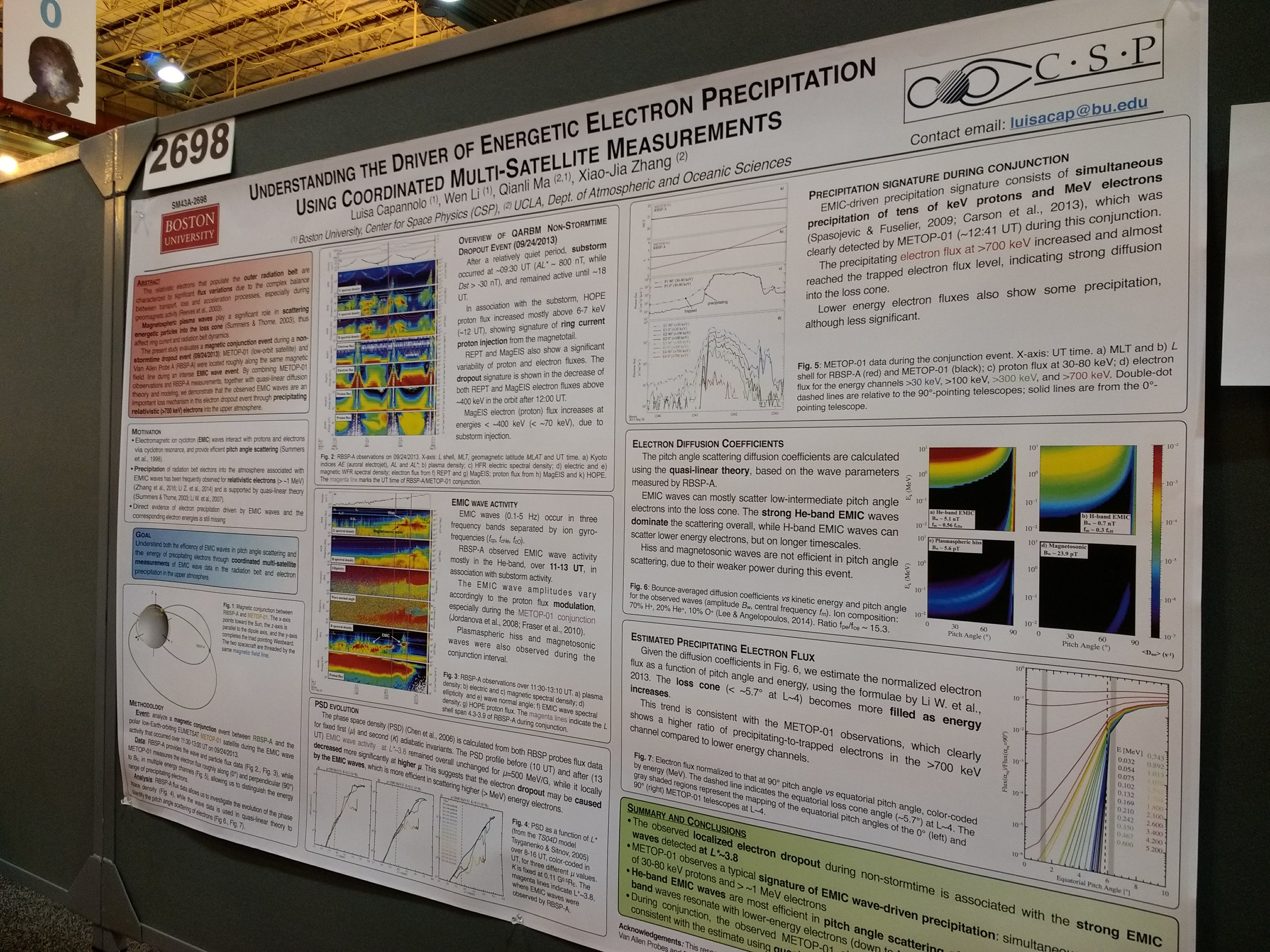My research interest focuses on Space Physics and I have been passionate about it since my last year of high school.
Before coming to Boston University, I earned my Bachelor’s degree and my Master’s degree in Physics at the University of L’Aquila. My research there was focused on the Earth’s magnetosphere and, more in detail, on its response to interplanetary magnetic shocks. I have analyzed over 200 shocks in interplanetary space (1998-2008) and their effects on the Earth’s magnetic field in order to compare the magnetospheric response with the Tsyganenko 2004 model that theoretically provides the terrestrial magnetic field. For any further details, please feel free to contact me.
At Boston University, I joined Prof. Merav Opher‘s research group and I switched to studying Coronal Mass Ejections (CMEs). When a CME impacts the terrestrial magnetosphere, it can drive geomagnetic storms and all the associated space weather effects (malfunction of communication systems, damages to power grids, etc.). Some CMEs, however, undergo significant deflections, such that they change their trajectory before reaching 1 AU. My first project at BU focused on modeling the trajectory of Coronal Mass Ejections (CMEs) with Christina Kay‘s ForeCAT model (Kay et al., 2015).
We have successfully reproduced the complex trajectory of the “Cartwheel” CME, a very peculiar CME that showed both rotation and a double latitudinal deflection (Capannolo et al., 2017). I have also used the Michigan BATS-R-US code (SWMF, Toth et al., 2012) to run simulations on CMEs, focusing on the magnetic reconnection that can occur while a CME travels in space.

BATS-R-US initiation of a CME (field lines in blue) within the solar corona (magnetic field lines in yellow)
Currently, I am working in Prof. Wen Li‘s group of research, which focuses mainly on the terrestrial radiation belts dynamics. We are interested in understanding the driver of energetic electron precipitation in the upper atmosphere. Energetic electrons that populate the radiation belts can cause damages to spacecraft, alter the upper atmosphere chemistry, and endanger the health of passengers on board of polar flights and astronauts. Waves occurring in the magnetosphere can interact with radiation belts particles and cause loss and/or acceleration. We try to correlate the waves observed in the magnetosphere using the Van Allen Probes to the precipitation of electrons at ~500-800 km of altitude with low-orbiting satellites such as NOAA POES and CubeSats such as FIREBIRD-II and ELFIN.
So far, we have found that electromagnetic ion cyclotron waves drive precipitation of electrons with energy as low as hundreds of keV. This feature is quite surprising given that current theories explain precipitation due to EMIC waves only above ~1 MeV.
The wide variety and abundance of space physics data and the intrinsic correlations between phenomena from the Sun down to the ionosphere are ideal to be studied with machine and deep learning (which I find fascinating). Using supervised deep learning, I was able to develop a long short-term memory (LSTM) model that is able to identify relativistic electron precipitation and also classify these events into two main groups: precipitation driven by waves and precipitation driven by the stretching of the magnetic field lines. In the future, I am hoping to use solar wind and solar data as input to a deep learning model to provide predictions of such precipitation events without having to rely on LEO satellites.
Check out my recent publications and conference posters:
- “Identification and Classification of Relativistic Precipitation Events at Earth Using Supervised Deep Learning” (Capannolo et al., 2022)
- “Relativistic Electron Precipitation Near Midnight: Drivers, Distribution, and Properties” (Capannolo et al., 2022)
- AGU 2021 invited talk on “Evidence of Sub-Relativistic Electron Precipitation […] in Association with EMIC Waves”
- “Energetic Electron Precipitation Observed by FIREBIRD‐II Potentially Driven by EMIC Waves: Location, Extent, and Energy Range from a Multi‐Event Analysis” (Capannolo et al., 2021)
- AGU 2020 eLightning poster
- AGU 2019 eLightning poster
- “The Deflection of the Cartwheel CME: ForeCAT Results” (Capannolo et al., 2017)

